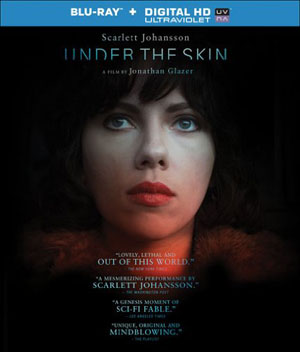 UNDER THE SKIN
UNDER THE SKIN
(R)
MOVIE: ****1/2 (out of 5)
BLU-RAY EXPERIENCE: *** (out of 5)
STARRING
Scarlett Johansson as THE WOMAN
Studio: A24
Directed by: Jonathan Glazer
BY KEVIN CARR
There was a time, not too long ago, that I was unimpressed with Scarlett Johansson. Sure, she’s easy on the eyes, but I never really connected with a lot of her performances. This year, that has changed, and I am now watching her career with great interest.
It’s not because she’s a key figure in the Marvel Cinematic Universe. After all, there’s far more interesting personalities swirling around that franchise. (Though I will say that her characters has been given a chance to grow and develop some depth with “Captain America: The Winter Soldier,” which makes her more interesting than her rather two-dimensional version of eye candy that we were introduced to in “Iron Man 2.”)
Finally, it seems that Johansson is making some bold, impressive choices with the movies she chooses. She’s no longer trying to corner the rom com market or play the aloof-but-beautiful characters we’ve seen in “The Nanny Diaries” and “We Bought a Zoo.” She’s choosing some real out-of-the-box films – from the ass-kicking drug mule in “Lucy” to this year’s earlier release “Under the Skin.”
It’s tempting to call “Under the Skin” an ego piece for her considering how much screen time she commands and how many close ups she gets. I really don’t see it that way. She shows quite a range in this thriller, letting a personality evolve on screen in a story of alien discovery.
“Under the Skin” is a slow burn film that follows a mysterious woman who has questionable origins. Supported by equally an equally mysterious clean-up crew, Johansson plays a being that hunts young men in Scotland, first vetting them for being loners who won’t be missed, then luring them back to out-of-the-way locations where she harvest them for an unexplained, alien purpose.
However, as the being inhabits the skin of a human, it becomes fascinated with the human condition. When it starts to act on its desires to try to be one by mimicking the most basic functions, she becomes hunted by her own kind.
Like an abstract painting, there’s not a lot happening on the surface, and “Under the Skin” can be dismissed as a drawn-out piece of narcissistic filmmaking. However, it challenges the viewer to look deeper under its surface flesh. Through the lens, we see our own world with an alien perspective, and we can find ourselves wondering at the things that would make humanity appealing to an otherworldly being.
It is this relativistic perspective – both from a moral standpoint and a visceral standpoint – that allows us to see how we might act in different situations, and why it would look so strange from another being’s eyes. There is plenty of bad behavior in this movie, but it presents the story without necessarily bad guys. In the end, animalistic instinct can be devastating to our own kind, but it can also be an unexpected hero.
“Under the Skin” stands along with “Enemy” and other bold releases from A24 as one of the leading voices in science fiction and speculative tales. It’s not the most straightforward film you’ll see this year – nor will it be the most straightforward film with Scarlett Johansson you’ll see this year – but it’s one of the better ones out there.
There’s not a huge amount of special features, but they are interesting to watch. The bonus material is gathered into a series of making-of featurettes that cover casting, script development, special effects and music, among other subjects. They do seem to be thrown in as an afterthought in post-production, but there’s an unexpected amount of informative material in there rather than the standard publicity parroting we see in other special features. Taken together, the making-of featurettes run about 42 minutes in total.
While little said in the behind-the-scenes is an overt surprise, it still deals with some fascinating elements of filmmaking, particularly the casting of Adam Pearson in the role of a man suffering from neurofibromatosis rather than using prosthetics, how the various visual effects were used to enhance practical ones, and how the production managed to film guerilla style and achieve spontaneous (and budgetary restricted) locations.
